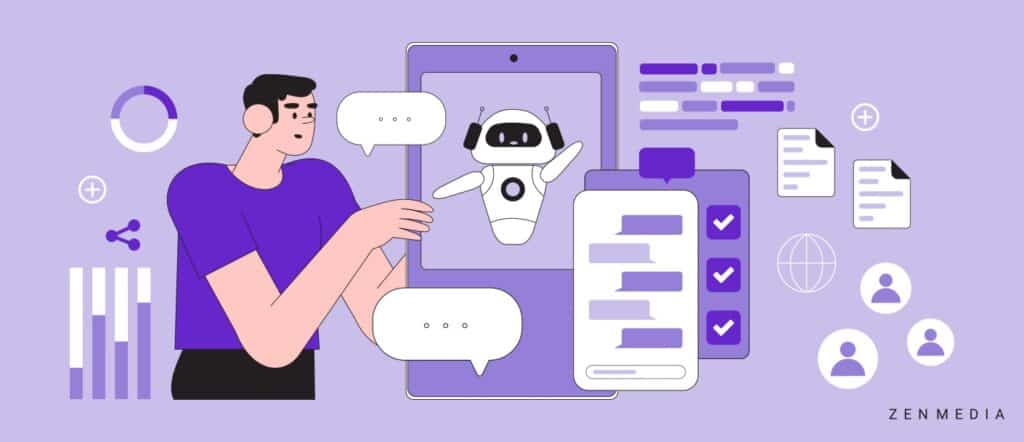As the world becomes increasingly digital, the demand for fresh, captivating content has skyrocketed. Artificial intelligence has played a significant role in providing new ideation opportunities, altering our professional and personal lives.
It’s crucial for marketers to keep up with the latest tools and techniques, including the most recent buzzword in the AI space: generative AI.
Understanding Generative AI
Generative AI technology isn’t as mysterious as it seems. To fully understand its functionality, you must look past the hype and slightly confusing jargon. First, we must distinguish the difference between generative AI and machine learning.
Machine learning enables computers to learn from preexisting data sets to provide key insights and predicted probabilities. This AI model analyzes and draws inferences from patterns discovered within the data. However, generative AI goes beyond ML by using large language models to not only learn from data but develop new content that mimics human-generated content.
As part of the new era of artificial intelligence, generative AI is a transformative technology, revolutionizing many industries, including marketing. While the concept of generative AI is nothing new, major developments didn’t start until the 21st century. Generative AI implementations have become immensely popular, especially since the release of ChatGPT in November 2022.
One of generative AI’s most powerful capabilities is the ability to self-supervise its learning from existing data as it identifies patterns that allows it to generate various kinds of output. Anything from pictures, music, and video to dynamic B2B content creation and targeted advertising campaigns—the applications are vast and promising regardless of how niche the category.
Although generative AI can produce incredible results, it still requires human interactions throughout the training process to achieve optimal outcomes.
How Generative AI Works
Generative AI differs from other AI models as it does not rely solely on training data but also on algorithms to create new data similar to training data.
Think about learning how to draw a dog—or whichever animal you’d like (we’re partial to puppies, though). Before putting pen to paper, you must first see what a dog looks like and its distinct characteristics that make it that specific animal. A wagging tail, sharp teeth, and maybe some floppy ears are all traits that give you an idea of what a dog is. Now, you can come up with your own variation after looking through enough examples.
The same idea applies to generative AI.
Gen AI equips several components to efficiently generate data for specific tasks. Those features include:
- Neural networks: a type of algorithm designed to process and analyze data to generate new content that exhibits human-like creativity based on the input data
- Input data: any information (data) that’s sent to the system for processing and to ensure the right task is executed
- Variational autoencoders (VAEs): a type of neural network that can learn to encode and decode data, compressing or reverting data to its original form. VAEs can be trained on a wide range of data types, including images, audio, and text
- Pre- and post-processing modules: ensures the input data is as concise as possible and the generated results are refined
- Generative adversarial networks (GANs): another type of neural network consisting of a generator and a discriminator, which work together to generate new data similar to the training data.
With extensive capabilities and almost endless possibilities, marketers should consider the advantages and limitations when using this technology.
Related post: An Overview of Google’s Search Generative Experience With AI
The Risks of Using Generative AI
As AI becomes more embedded in our lives, it’s crucial to understand the moral and ethical considerations of generative AI use. Some risks are due to technology itself, and others are still being worked out as gen AI evolves. Here are a few generative AI limitations you must keep in mind.
Content Quality
Although generative AI has come a long way, the quality of the content it creates can vary depending on its accuracy and coherence. Generative AI can combine existing ideas within its data sets in new ways but has limitations when it comes to true innovation and spontaneous creativity, which lies within human capacity.
While generative AI adds a layer of efficiency to your routine, the content could be lackluster. You don’t want to be the one putting out consistent content that’s repetitive or, worse, doesn’t make sense! Additional human supervision can help prevent poor content quality before it gets too bad.
False Information
AI tech tends to hallucinate, meaning it generates false information in a totally convincing manner. Because open-source AI systems usually undergo less stringent alignment standards, the potential for misinformation or inaccurate data to spread is significantly increased. AI false information and propaganda can also impact your audience’s trust.
This makes fact-checking your AI-generated content all the more important. Misinformation can spread like wildfire, with AI-generated texts, images, and videos being manipulated to deceive or mislead. Businesses must be cautious about how their Generative AI technologies are deployed to ensure they are not inadvertently facilitating the spread of false information.
Biases
One major ethical AI consideration is unregulated biases. Since AI models learn from their training data, they may reproduce and amplify existing biases, potentially promoting harmful ideologies, discriminatory outputs, and other content with malicious intent.
Like false information, biases can spread swiftly without double-checking the information. Mitigating this risk involves collecting data from a wide range of sources and ensuring it’s balanced and reflective of different political and racial viewpoints and groups.
Despite the limitations to watch out for, using AI generation can’t be all bad, right?
Correct! It can actually be more advantageous than you think, especially for marketers and their B2B brands.
The Pros of Generative AI
Generative AI has many benefits to leverage, both current and potentially in the future. Its ability to automate tasks, generate realistic images, and provide valuable insights, enables businesses to gain a competitive edge in the marketplace. More pros include:
Enhancing Creativity
Generative AI provides new ideas, designs, and solutions to augment human brainstorming. This fresh perspective can be especially valuable when creators become stuck in a rut or run into content fatigue. Also, generative AI can provide multiple scenarios to increase ideation for various situations and add to your reserve of backup proposals.
Streamline Content Production
Generative AI can automate time-consuming assignments and workflows at a larger scale, such as content creation or data generation. Individuals can save more time and boost productivity with AI’s capacity to generate substantial content at once. This increases overall efficiency, optimizing how we work and the tasks we work on.
Personalize Customer Experiences
In addition to processing and producing substantial content, generative AI can generate accurate and relevant content tailored to specific audiences. Generative AI can power many tools to help businesses support their customers, including chatbots and virtual assistants.
With specific input data, systems can create precise results, ensuring the success of digital marketing campaigns.
Now that you know a general lay of the land in the generative AI world, let’s examine how it can be applied in the real world.
Generative AI in B2B Marketing
So, what can generative AI do for your brand? How do you even get started? Well, the implementation of generative AI into your marketing strategies can happen in multiple ways, all poised to enable businesses to transform their operations.
Data-enriched insights are a main component of creating dynamic content, developing targeted advertising campaigns, and improving customer engagement through personalized experiences. Relevant and high-quality content also drives conversion rates—it’s all about giving your audience what they want!
What’s Next For Business Leaders and a Generative AI Platform
While generative AI continues to develop, its future looks bright. And as the digital marketing landscape continues to shift, so do the capabilities of generative AI.
Generative AI is a game-changer when it comes to content and B2B marketing. By offering the ability to produce personalized content on a mass scale, businesses can improve engagement and increase conversions. The future of content and marketing will continue to be transformed by the power of Generative AI tools.
The potential of generative AI offers business leaders numerous opportunities to innovate within their industry, taking their companies to the next level.
The first step in getting the hang of a complex topic is to understand how it works. Hopefully, this blog brought you more insight into how to use generative AI more effectively in your brand marketing.
If you want to enhance your comprehension of generative AI, check out our blogs for more.



